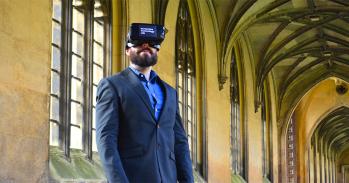
The expertise of Cambridge's new Professor of Clinical Microbiology, Sharon Peacock, is helping to drive a programme of research that will track and block routes of transmission for superbugs.
The expertise of Cambridge's new Professor of Clinical Microbiology, Sharon Peacock, is helping to drive a programme of research that will track and block routes of transmission for superbugs.
Tracking how MRSA spreads can be likened to playing detective since it’s all about trying to identify and follow specific strains of bacteria as they move globally, between countries and between individuals."
Sharon Peacock
On returning to the UK after seven years in Thailand researching infectious diseases, Cambridge's new Professor of Clinical Microbiology, Sharon Peacock, has taken up with an 'old friend', as she resumes her long-standing research interest in the bacterium Staphylococcus aureus, particularly the MRSA strains that have become resistant to the antibiotic drug methicillin. The increasing incidence of antibiotic resistance in such bacteria is a global health threat. Her expertise is helping to drive a programme of research that will track and block routes of transmission for these 'superbugs'.
Based within the Departments of Medicine and Pathology, and working closely with the Health Protection Agency and the Wellcome Trust Sanger Institute, Professor Peacock has recently returned from the Mahidol-Oxford Tropical Medicine Research Unit in Thailand. There, she directed a wide-ranging programme of bacterial disease research focused on prevalent diseases in South-East Asia. This included clinical treatment trials, diagnostic test development and the molecular epidemiology of several bacteria.
Professor Peacock has also had a long-term interest in MRSA, which over the past four decades has spread around the world and is resistant to many of the antibiotics commonly used in hospitals. ‘Tracking how MRSA spreads can be likened to playing detective since it’s all about trying to identify and follow specific strains of bacteria as they move globally, between countries and between individuals,’ she explained. ‘It’s important that we can do this because measures can then be introduced to further reduce transmission in settings where the bacteria pose the greatest problem such as hospitals.’
Through a collaboration with the Wellcome Trust Sanger Institute, her research has already had a dramatic impact on moving forward the detective story: in 2004, the genome of the MRSA strain that is a common cause of hospital-based infection in the UK was sequenced; and in January 2010, a new method for tracking transmission routes based on the rapid sequencing of genetic differences between strains was published in Science. Her focus now is to translate these research tools from the laboratory into the clinical setting, so that preventive interventions can then be targeted with precision and according to need
What’s the best piece of advice you’ve ever been given?
‘Make it hard, but make it look easy’; in other words, challenge yourself, but don’t let on that it’s so difficult. I’ve always tried not to settle into a comfort zone for very long before I’m looking for the next challenge, and the one after that.
Have you ever had a Eureka moment?
Yes – when I realised that what I really wanted to be was a doctor. But, at the time, I was six months into student nurse training, and having left school at 16 almost empty handed and without the O-levels I needed to study medicine. It was only when I saw how enthralling the whole diagnostic process was – taking a history, examining the patient, carrying out investigations, and reaching a diagnosis – that I knew that’s what I wanted to do. I had a very long way to go to achieve it. I did my O-levels at night school, then my A-levels part-time while working as a nurse to fund myself. It was quite difficult to get into University to study medicine because of this unusual background, but Southampton University gave me the opportunity. I haven’t really had a Eureka moment since – I’ve just been trying to achieve what I set out to do all those years ago!
If you could wake up tomorrow with a new skill, what would it be?
Wouldn’t it be good to wake up and realise you could run a marathon? I’m a very keen spinner – it’s a fitness regimen using a specially designed stationary bike – and I’d love to have the fitness of a marathon runner.
What is your favourite research tool?
There’s no doubt that access to information on the scale the internet provides has revolutionised the way we do our work. It’s hard to imagine that, when I was a medical student, finding scientific articles involved a trip to the library and locating the right volume of Index Medicus on a bookshelf, all to provide what PubMed does at the touch of a button. The other major research tool for me is the advent of high-throughput sequencing technology, and the speed with which we can now sequence genomes and tell individual strains of bacterial pathogens apart, some of which may only differ at a few bases of DNA. It’s an incredibly powerful tool in the battle against the spread of bacteria.
What will the future look like in 2050?
Antibiotic resistance in bacteria is a result of the widespread use of antibiotics over recent decades. Unless we embark on a better global vision for conserving the efficacy of current drugs by limiting their use, this will be a major problem in the future. However, we’ll have a better genetic understanding of bacterial pathogens and based on this I hope that we’ll be able to identify weaknesses that can be targeted with a new generation of antibiotics. And, crucially, many of the technologies that are now becoming available for diagnosing and tracking disease will be translated into cost-effective clinical tools. Even in the face of rising antibiotic resistance, we’ll have the front-line measures to understand and reduce bacterial transmission and limit the spread of infection.
This work is licensed under a Creative Commons Licence. If you use this content on your site please link back to this page.





